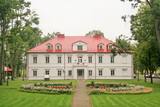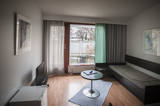| Нo | Название | Описание |
|---|---|---|
|
Эта недавно реконструированная усадьба середины XIX в. в окружении красивого старого парка находится в Северной Литве, в 14 км от Паневежиса. Архитектурный ансамбль усадьбы Бистрамполис состоит из построек второй половины XIX — начала ХХ в.: двухэтажного дворца в стиле классицизма (середина XIX в.), конюшни, ледника, домика садовника, надворных построек. Украшением усадьбы является парк смешанного типа с прудами, разбитый здесь во второй половине XIX в. В усадебном парке, на горе Бируте красуется чудесная беседка, рядом притаился домик садовника. Силуэт парка оживляют заново проложенные дорожки и мостики, соединяющие парковые пруды. |
||
|
Хозяйство «Вилцини» – одно из крупнейших и современейших сельскохозяйственных производственных предприятий в Земгале, которое применяет методы работы, дружественные по отношению к окружающей среде. Хозяйство «Вилцини» находится в самом сердце исторического края Земгале, в Кримунской волости. История хозяйства уходит корнями в 1991 год, когда на это место пришли родители руководителя хозяйства – Арниса Бурмистриса. На данный момент обрабатывается ~ 2200 га земли (специализация – зерновые). Хозяйство использует точные методы ведения сельского хозяйства, что помогает экономить средства, а также сохранить окружающую среду и здоровье человека. Хозяйство активно включается в освоение финансирования фондов ЕС. Создан парк современной сельскохозяйственной техники, установлена местная метеорологическая станция. Экскурсии по хозяйству. |
||
|
Guests to the Dīķīši homestead in the Amata Parish will be greeted by several Samoyed dogs and intelligent little donkeys that will bring the guests to a place for glamping next to the pond. You can hike down two trails of different lengths of enjoy the opportunities that exist when Latvians share places where they find mushrooms and berries. A special adventure is creating artworks from natural materials that have been collected in the forest. The accommodations are appropriate for people who use a wheelchair. The lavatory has been adapted to the needs of such people, as well. People who are interested in cultural history can tour a collection of Latvian folk costumes, trying them on and organising their own photo session. People who enjoy extreme feelings will enjoy a ride on a quadricycle. If you love to go fishing, bring your own inventory. We organise fire rituals for birthdays and family celebrations, and we’ll also offer soup that has been cooked on a campfire, as well as a master class in cheesemaking. |
||
|
Находится в центре Пиньки, на улице Ригас. Посвящен событиям 1919-го года, когда 22-го мая после почти двухмесячного бездействия бригада полковника Балодиса пошла в наступление на Ригу для освобождения столицы от большевиков. Поддержку бригаде Балодиса должны были оказать немецкий ландесвер и немецкая «Железная дивизия», а также отделение русского князя Ливена. Первый памятник был открыт президентом Латвии Карлисом Улманисом 23-го мая 1939-го года. В 1951-м году советская власть его уничтожила, а в 2003-м году была установлена копия памятника (скульптор Я. Бриедис, копия О. Скарайниса). |
||
|
Puises ragā (Puise nina) ir uzcelts divstāvīgs atpūtas nams, kas apvienots ar putnu vērošanas torni. No tā paveras skats uz piekrasti, kas ir iecienīta migrējošo zosu atpūtas vieta. Šī ir privāta teritorija, kuras apskati vēlams saskaņot ar īpašnieku. |
||
|
Мотель Marine расположен недалеко от центра Экенеса, в минуте ходьбы от пляжа. Здесь круглосуточно работает рецепция и всегда готова вам помочь. Этот мотель предлагает различные типы номеров, от одноместных до больших семейных номеров с кухней. Все комнаты имеют отдельный вход. В мотеле также есть ресторан и сауна. |
||
|
Кемерская водонапорная башня –
построена в 1929 году. В свое время в башне
хранились запасы питьевой и минеральной
воды. До Второй мировой войны гости курорта
могли любоваться окрестностями Кемери с
высоты 42метровой площадки, которая была
обустроена на самом верху башни.
|
||
|
Lauku sēta ar pirti atrodas Merkys upes krastā, ciema nomalē meža tuvumā. Piedāvā programmu "Griķu ceļš no sēklas līdz galdam", iespējams nobaudīt tradicionālos ēdienus. Piedāvā arī nakšņošanu. |
||
|
Находится в начале главной улицы Кулдиги для пешеходов и велосипедистов - улицы Лиепаяс. Размещен в архитектурно интересном двухэтажном деревянном здании, где когда-то был амбар. Латышская кухня: Крестьянский завтрак, овсяная каша, холодный суп на кефире, суп из щавеля, огурцов и фасоли, говядина в луковом соусе, охотничьи колбаски, картофельные блины, сладкие блинчики с брусничным соусом. |
||
|
Находится на ул. Базницас, д. 7. Красивое деревянное здание, построенное около т.н. мостика Кулдигской Венеции через Алекшупите в 1670 году. На крыше здания можно увидеть один из старейших и самых красивых флюгеров города. |
||
|
Gebaut in 1610, später umgebaut. Eins der hervorragenden Gebäuden Litauens der Renaissance. Eine Ausstellung der Kunstakademie Vilnius. Ein Aussichtsturm. |
||
|
One of the richest sources of sulphurous water in Latvia.
|
||
|
Полюбившееся место в центре Огре. Находятся в здании, построенном до Первой мировой войны, где в советское время размещался участок милиции. Предлагают музыкальные вечера. Латышская кухня: Сырное ассорти из сыров «Сиерштеллес», суп из баранины, грибной суп, перловая каша с грибами, филе сома, сорбет из лесных ягод, блины. Особое блюдо: запеченное сырное пирожное с ягодами. |
||
|
В саду можно осмотреть множество экзотических и редких видов растений, цветов и деревьев. |
||
|
Netālu no augstākā Latgales augstienes paugura – Lielā Liepukalna atrodas zemnieku saimniecība, kuras darbnīcā amatnieks Jānis Kuzminskis taisa mūsdienīgas ģitāras u.c. mūzikas instrumentus. Apmeklētāji var iepazīt Jāņa veidoto ekspozīciju, vērot amatnieka darbošanos, pasūtīt sev jaunu instrumentu, kā arī muzicēt pie bagātīgajā kolekcijā savāktajiem instrumentiem. Saimniece stāsta par Latgales kulinārā mantojuma ēdieniem un rāda, kā gatavo gulbešnīkus. |
||
|
At the end of the Pakri peninsula is the most visually impressive shoreline cliff in the Baltic States – the Pakri cliff (Pakri pank), which is as much as 24 metres high. During cold winters, streams which flow from the layers of limestone cliffs form fantastic and unusual shapes of ice.
|
||
|
Находится в 250-летнем доме для прислуги Рундальского замка, где сохранились кирпичные кладки того времени, печь из горшочного камня, кухня-очаг-дымоход, каменные стены которой постепенно переходят в трубу и другие предметы истории. Блюда подаются в старинной посуде, а напитки подносят в чашечках фабрики Кузнецова. Латышская кухня: Жареный окорок с яйцом, картофель с грибным соусом, жареный гусь, вареные в укропе раки, блины с медом, хлебный суп с взбитыми сливками, слойка из хлеба, деревенские чаи, яблочный пирог. Особое блюдо: На вертеле жареная свинина с запеченным в печи картофелем. |
||
|
Один из авторитетов и учителей банщиков Зиедонис Карклиньш использует в ритуалах многие различные веники для энергетического воздействия. Во время одного парения используется 12 и более веников из разных растений, натуральная косметика и натуральные материалы (глина, янтарь, грязи, камни и др.). В банных ритуалах банщик применяет древние энергетические знаки балтов. |
||
|
Самый широкий водопад в Балтии – шириной примерно 249 м и высотой до 1,75 м. Это не только важный природный, но и культурно-исторический объект, так как устройство для ловли рыбы, придуманное Курляндским герцогом Екабом Кетлером, закреплялось на каменистых ступенях водопада. Так появилась история о городе, где лосось (мигрирующие лосось и вимба прыгали через водопад и попадали в сети) ловится в воздухе! Для того чтобы обеспечить судоходство по Венте, во времена герцога Екаба приступили к строительству канала в обход водопада. В начале XVIII в. витала идея о соединении Балтийского и Черного морей по Венте, Неману и Днепру. По этой причине военнопленные турки должны были продолжать рытье канала, которому мешала доломитовая скала. Внушительная канава канала видна и сегодня. В 2012 году на правом берегу Венты построили деревянные мостки. Здесь надо быть в разное время года – во время миграции, как вимбы (весной), так лосося (осенью). |
||
|
Гостевой дом находится в 300-летнем здании пивоварни Омульского фольварка, расположенного в 20 км от Валки. Хозяйство занимается производством домашних копченостей, сыров, белого хлеба, кисло-сладкого и ржаного хлеба. Подворье со скотом, баня. |
||



























